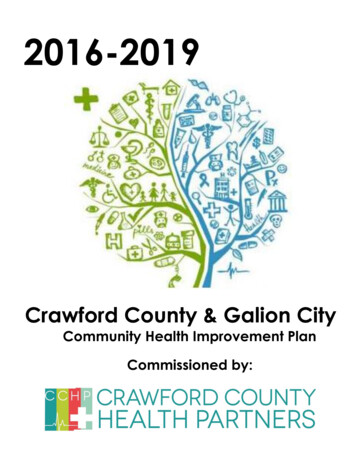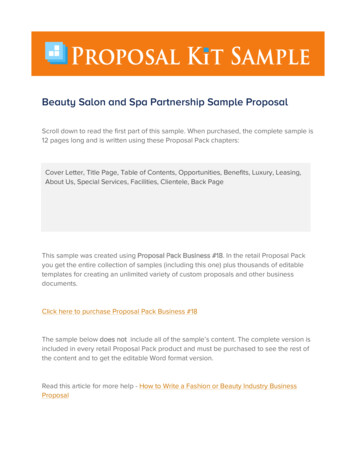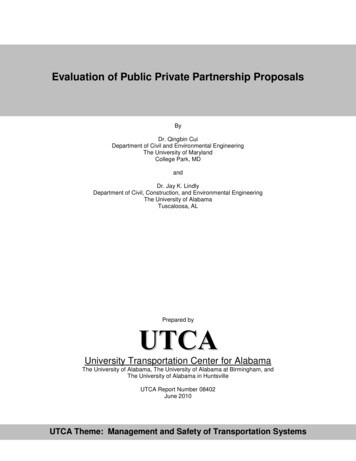
Transcription
2016-2019Crawford County & Galion CityCommunity Health Improvement PlanCommissioned by:i
ii
TABLE OF CONTENTSExecutive SummaryPages 1-3PartnersPage 4VisionPage 5Alignment with National and State StandardsPage 5-6Strategic Planning ModelPage 6Needs AssessmentPages 7-9Priorities ChosenPage 10Forces of ChangePage 11Local Public Health System AssessmentPages 12-13Community Themes and StrengthsPages 14-15Quality of Life Survey ResultsPage 16Resource AssessmentPage 17Priority #1 Decrease ObesityPages 18-31Priority #2 Decrease Adult Cardiovascular DiseasePages 32-42Priority #3 Decrease Youth Substance AbusePages 43-59Priority #4 Improve Prenatal OutcomesPages 60-63Trans-StrategiesPages 64-65Measuring Outcomes & Contact InformationPage 66iii
EXECUTIVE SUMMARYIn 2015, the Crawford County Health Partners began conducting community healthassessments (CHA) for the purpose of measuring and addressing health status. The mostrecent Crawford County Health Assessment, conducted by the Hospital Council ofNorthwest Ohio, was cross-sectional in nature and included a written survey of adults withinCrawford County. The questions were modeled after the survey instruments used by theCenters for Disease Control and Prevention for their national and state Behavioral RiskFactor Surveillance System (BRFSS). This has allowed Crawford County to compare the datacollected in their CHA to national, state and local health trends. The Crawford-MarionADAMH Board also conducted a youth survey in collaboration with Crawford Countysuperintendents. The data from the youth survey was reviewed and incorporated as a partof this process as well.Crawford County CHA also fulfills national mandated requirements for the hospital in ourcounty. H.R. 3590 Patient Protection and Affordable Care Act states that in order tomaintain tax-exempt status, not-for-profit hospitals are required to conduct a communityhealth needs assessment at least once every three years, and adopt an implementationstrategy to meet the needs identified through the assessment.From the beginning phases of the CHA, community leaders were actively engaged in theplanning process and helped define the content, scope, and sequence of the project.Active engagement of community members throughout the planning process is regardedas an important step in completing a valid needs assessment.The Crawford County CHA has been utilized as a vital tool for creating the Crawford CountyCommunity Health Improvement Plan (CHIP). The Public Health Accreditation Board (PHAB)defines a CHIP as "a long-term, systematic effort to address health problems on the basis ofthe results of assessment activities and the community health improvement process. Thisplan is used by health and other governmental education and human service agencies, incollaboration with community partners, to set priorities and coordinate and targetresources. A CHIP is critical for developing policies and defining actions to target efforts thatpromote health. It should define the vision for the health of the community inclusively andshould be done in a timely way."To facilitate the Community Health Improvement Process, the Crawford County HealthDepartment and the Galion City Health Department along with the local hospital, AvitaHealth System, invited key community leaders to participate in an organized process ofstrategic planning to improve the health of residents of the county. The NationalAssociation of City and County Health Officials (NACCHO) strategic planning tool, Mobilizingfor Action through Planning and Partnerships (MAPP), was used throughout this process.The MAPP Framework includes six phases which are listed below Organizing for success and partnership development Visioning Conducting the MAPP assessments Identifying strategic issues Formulating goals and strategies Taking action: planning, implementing, and evaluation1
The MAPP process includes four assessments: Community Themes & Strengths, Forces ofChange, the Local Public Health System Assessment and the Community Health StatusAssessment. These four assessments were used by the Crawford County Health Partners toprioritize specific health issues and population groups which are the foundation of this plan.The diagram below illustrates how each of the four assessments contributes to the MAPPprocess.Strategies:1.2.3.4.Priority Health Issues for Crawford CountyDecrease ObesityDecrease Adult Cardiovascular DiseaseDecrease Youth Substance AbuseImprove Prenatal Outcomes2
Action Steps:To work toward decreasing obesity, the following action steps are recommended:1.Participate in the Healthier Food Challenge of Healthier Hospitals2.Increase Nutrition/Physical Education Materials Being Offered to Patients byPrimary Care Offices3.Increase Education of Healthy Eating for Adults4.Establish a Crawford County Obesity Coalition5.Increase Businesses/Organizations Providing Wellness Programs and/orInsurance Incentive Programs to Their Employees6.Explore The Possibility Of Recruiting A Bariatric Surgeon And Creating A BariatricSurgery ProgramTo work toward decreasing adult cardiovascular disease, the following actionssteps are recommended:1.Initiate a Community–Based Walking Program2.Increase Nutrition/Physical Education Materials Being Offered to Patients byPrimary Care Offices3.Implement Tobacco PoliciesTo work toward decreasing youth substance abuse, the following actions steps arerecommended:1.Increase Awareness of Trauma Informed Care2.Expand the Operation Street Smart Program3.Expand Evidence-based Programs and Counseling Services Targeting Youth4.Continue and Enhance Leader In Me (LIM) in Crawford County5.Increase The Number Of Primary Care Physicians Screening For DepressionDuring Office VisitsTo work toward improving prenatal outcomes, the following actions steps arerecommended:1.Implement Pathways Model2.Increase the Use of Safe Sleep Practices3.Increase Breastfeeding PracticesTo work toward addressing all four priority areas, the following trans-strategies arerecommended:1.Create and Distribute A County-Wide Resource Assessment2.Increase Transportation Through A County Transportation Plan3.Create a Consistent Message4.Market the CHIP with Crawford County Community Leaders3
PARTNERSThe 2016-2019 Community Health Improvement Plan was drafted by agencies andservice providers within Crawford County. During the past several months, thecommittee reviewed many sources of information concerning the health and socialchallenges Crawford County adults and youth may be facing. They determinedpriority issues which if addressed, could improve future outcomes, determined gaps incurrent programming and policies and examined best practices and solutions. Thecommittee has recommended specific actions steps they hope many agencies andorganizations will embrace to address the priority issues in the coming months andyears. We would like to recognize these individuals and thank them for their devotionto this process and this body of work:Crawford County Health PartnersBrad DeCamp, Crawford-Marion ADAMH BoardCarrie Betts, Avita Health SystemCinda Kropka, Avita Health SystemCindy Wallis, Community Counseling ServicesCrystina Wallar, Family & Children First CouncilDeena Smith, Bucyrus YMCADeEtta Shaffer, Galion City Health DepartmentGary Frankhouse, Crawford County Education and Economic Development PartnershipJody Demo-Hodgins, Crawford-Marion ADAMHJoe Stafford, Community Counseling Services & Restore MinistriesKate Siefert, Crawford County Public HealthKathy Bushey, Crawford County Public Health WICLisa Workman, The Community Foundation for Crawford CountyMadeline Novack, MaryhavenMary Jo Carle, Together We Hurt, Together We HealPam Kalb, Crawford County Public Health Help Me GrowPaula Brown, MaryhavenSis Love, City of BucyrusStephanie Zmuda, Galion City Health DepartmentSteve Jozwiak, Crawford County Public HealthTom O’Leary, City of GalionTrish Factor, Galion City Health DepartmentThis planning process was facilitated by Britney Ward, Director of Community HealthImprovement, and Tessa Elliott, Community Health Improvement Coordinator, fromthe Hospital Council of Northwest Ohio.4
VISIONVision statements define a mental picture of what a community wants to achieveover time while the mission statement identifies why an organization/coalition existsand outlines what it does, who it does it for, and how it does it.The Vision of Crawford County Health Partners:Making healthy happen in Crawford County through collaboration, prevention andwellnessThe Mission of Crawford County Health Partners:To bring together people and organizations to improve community wellness inCrawford CountyALIGNMENT WITH NATIONAL, STATE AND LOCAL STANDARDSThe 2016-2019 Crawford County Health Improvement Plan priorities align perfectlywith state and national priorities. Crawford County will be addressing the followingpriorities: obesity, cardiovascular disease, youth substance abuse, and prenataloutcomes.Ohio State Health Improvement PlanCrawford County priorities very closely mirror the following 2015-2016 State HealthImprovement Plan (SHIP) Addendum priorities:Priority 1: Decrease Ohio’s Infant Mortality Rate and Reduce Disparities in BirthOutcomesPriority 2: Prevent and Reduce the Burden of Chronic Disease for All OhioansPriority 4: Promote Public Awareness, Policy, Programs and Data That DemonstrateThat Injury and Violence Are PreventableTo align with and support Priority 1 (Infant Mortality), Crawford County will work todecrease exposure to second hand smoke throughout the county. Furthermore,Crawford County will work to increase 1st Trimester prenatal care for pregnantCrawford County women as well as increase the use of safe sleep practice forinfants.To align with and support Priority 2 (Chronic Disease), Crawford County will work toincrease the number of businesses and organizations providing wellness programsand insurance incentives programs to their employees. Additionally, CrawfordCounty will work to adopt complete streets policies and implement a healthierchoices campaign in Crawford County schools.To align with and support Priority 4 (Injury and Violence), Crawford County will workto increase the number of health care providers screening for alcohol and drugabuse and expand the Operation Street Smart Program.U.S. Department of Health and Human Services National Prevention StrategiesThe Crawford County Plan also aligns with six of the National Prevention Strategies forthe U.S. population: healthy eating, active living, injury and violence free living andpreventing drug abuse and excessive alcohol use.5
ALIGNMENT WITH NATIONAL, STATE AND LOCAL STANDARDS, continuedHealthy People 2020Crawford County’s priorities also fit specific Healthy People 2020 goals. For example: Nutrition and Weight Status(NWS)-8: Increase the proportion of adults who are ata healthy weight Heart Disease and Stroke (HDS)-4: Increase the proportion of adults who havehad their blood pressure measured within the preceding 2 years and can statewhether their blood pressure was normal or high Substance Abuse(SA)-2: Increase the proportion of adolescents never usingsubstances Maternal, Infant, and Child Health (MICH)-1: Reduce the rate of fetal and infantdeathsThere are 21 weight control objectives, 16 heart disease and stroke objectives, 20substance abuse objectives, and 20 other maternal, infant, and child healthobjectives that support the work of the Crawford County CHIP. These objectives canbe found in each individual section.STRATEGIC PLANNING MODELBeginning in May 2016, Crawford County Health Partners met four (4) times andcompleted the following planning steps:1. Initial Meeting- Review process and timeline, finalize committee members, createor review vision2. Choosing Priorities- Use quantitative and qualitative data to prioritize target impactareas3. Ranking Priorities- Ranking the health problems based on magnitude, seriousness ofconsequences, and feasibility of correcting4. Resource Assessment- Determine existing programs, services, and activities in thecommunity that address the priority target impact areas and look at the number ofprograms that address each outcome, geographic area served, preventionprograms, and interventions5. Forces of Change and Community Themes and Strengths- Open-ended questionsfor committee on community themes and strengths6. Gap Analysis- Determine existing discrepancies between community needs andviable community resources to address local priorities; identify strengths,weaknesses, and evaluation strategies; and strategic action identification7. Local Public Health Assessment- Review the Local Public Health System Assessmentwith committee8. Quality of Life Survey- Review results of the Quality of Life Survey with committee9. Best Practices- Review best practices and proven strategies, evidence continuum,and feasibility continuum10. Draft Plan- Review all steps taken; action step recommendations based on one ormore the following: enhancing existing efforts, implementing new programs orservices, building infrastructure, implementing evidence based practices, andfeasibility of implementation6
NEEDS ASSESSMENTCrawford County Health Partners reviewed the 2015 Crawford County HealthAssessment. The detailed primary data for each individual priority area can befound in the section it corresponds to. Each member completed an “IdentifyingKey Issues and Concerns” worksheet. The following tables were the group results.What are the most significant ADULT health issues or concerns identified in the 2015assessment report?Key Issue or Concern1. Weight Status (10 votes)ObeseOverweight2. Cardiovascular Disease (9 votes)High blood pressureHigh blood cholesterolStrokeHeart Attack3. Diabetes (9 votes)Diagnosed with diabetes4. Mental Health/Access (7 votes)Considered attempting suicideAttempted suicideFelt sad or hopeless for two or moreweeks5. Tobacco use (6 votes)Current smoker6. Prenatal outcomes (6 votes)Prenatal visit – 1st trimester7. Alcohol consumption (5 votes)Average number of drinksCurrent drinkerBinger drinker8. Drug overdose/poisoning (4 votes)9. Parenting (3 votes)Parent read to their child every dayNever breastfed childAffordable childcareFinancial burdenChild behaviorParent alcohol/drug useChild slept in bed with parent oranother personChild slept in crib/bassinette (nobumper, etc.)Child slept in crib/bassinette (withbumper, etc.)Age Group (orIncome Level)Most at Risk% of PopulationAt riskGenderMost at Risk35%40%Age: 30-64, 25KAge: 30, 25K -Male42%40%1%5%Age: 65 , 25KAge: 65 , 25K ---MaleMale---16%Age: 65 , 25KMale5%2%14%--Age: 30, 25K--Female20%Age: 30-64, 25KMale52%--Female3.9 drinks on average51%38%15.1 per 100,000Age: 30Age: 30Age: 30, 25K--FemaleMaleMale--20%32%9%33%25%1%50%-Income: 25K--------------51%----49%----7
NEEDS ASSESSMENT, continuedWhat are the most significant ADULT health issues or concerns identified in the 2015assessment report? (continued)Key Issue or Concern10. Screenings (3 votes)Had a mammogram in the past year (over 40)Had a PSA Test in the past year (over 50)11. Preventive medicine (2 votes)Pneumonia vaccine 65 12. Arthritis (2 votes)Diagnosed with arthritis13. Access to care (1 vote)UninsuredCould not see doctor because of cost14. Limitations for Seniors (1 vote)Limited in some way15. Educational attainment (1 vote)Less than High School DiplomaHigh School DiplomaSome college/college graduate% ofPopulation atRiskAge Group (orIncome Level)Most at RiskGenderMost at Risk53%49%------59%Age: 65 --32%Age: 65 --12%14%Age: 30, 25KIncome: 25KFemale--20%Age: 65 , 25KFemale4.8%40.5%50.8%--------8
NEEDS ASSESSMENT, continuedWhat are the most significant YOUTH health issues or concerns identified in the 2015assessment report?% ofPopulation atRiskKey Issue or Concern1. Substance abuse (14 votes)Marijuana useLife time drinker (of all youth)Binge drinker (of all youth)Current drinkerDrank alcohol before the age of 13 (of all youth)Rode with someone who was drinkingDrank and drove (of youth drivers)2. Tobacco Use (10 votes)Current smokerSmoked a whole cigarette at 10 years old or youngerSmoked more than 10 cigarettes per day (of currentsmokers)3. Hunger/malnutrition (7 votes)Percent of Crawford County youth on free/reducedlunch4. Bullying (6 votes)Bullied on school propertyElectronically bullied5. Parental involvement (4 votes)Parent always involved in educationParent seldom involved in educationParent never involved in education6. Texting and driving (4 votes)Youth drivers who texted or e-mailed while driving7. Mental Health/Depression (3 votes)2015 Crawford county penetration rate8. Obesity/lack of recreation (1 vote)Percent of Crawford County 3rd graders who wereoverweight/obese9. Infant low birth weight/Malnutrition (1 vote)Crawford County low birth weight percentage9Age GroupMost at RiskGender Mostat Risk21%45%15%21%12%13%7%Age: 17 Age: 17 Age: 17 Age: 17 ----Male--Female----11%18%19%Age: 17 --34%----62/1,000----33.6%----7.3%----
PRIORITIES CHOSENBased on the 2015 Crawford County Health Assessment, key issues wereidentified for adults and youth. Committee members then completed aranking exercise, giving a score for magnitude, seriousness of theconsequence, and feasibility of correcting, resulting in an average score foreach issue identified. Committee members’ rankings were then combined togive an average score for the issue.AverageScoreHealth IssueAdult ObesityAdult CardiovascularYouth Substance AbusePrenatal OutcomesYouth TobaccoAdult DiabetesAdult TobaccoYouth BullyingAdult Mental HealthAdult wford County will focus on the following four priorities over the next 3 years: Obesity Adult Cardiovascular Disease Youth Substance Abuse Prenatal Outcomes10
FORCES OF CHANGECrawford County Health Partners was asked to identify positive and negative forceswhich could impact community health improvement and overall health of thiscommunity over the next three to five years. This group discussion covered many local,state, and national issues and change agents which could be factors in CrawfordCounty in the near future. The table below summarizes the forces of change agentand its potential impacts.Force of ChangeImpact1. Ohio Department of Health (ODH)oReduction in vaccination fundingThe Children with Medical Handicaps Program(BCMH) not funded the same way2. Court programsoBetter outcomes for at-risk youtho3. Election year2016 is an election year. This could have positiveor negative effects on the residents and thecommunity as a wholeo Changes at county, state, and federal level4. TransportationoTransportation system now in place5. Aging populationo6. County debtoo7. Declining populationo8. Crawford worksooHigher medical expensesSkilled workers are retiringCrawford County unable to grow economicallyDeclining economic growthLoss of taxes and fundingPeople are leaving Crawford County for betteropportunitiesConnecting people to jobsGiving residents a second chance9. Access to clean wateroHealth of Crestline residentsoooCrisis Intervention Team (CIT) TrainingCommitted to the safety of Crawford Countyresidentso Losing funding due to online and home schoolso Kids are less social, isolatedo10. Law enforcement leadership11. Crawford County School Systemo12. Human traffickingoBecoming more prevalent in Crawford County13. State and Federal FundingoReimbursement vs. money up front14. ReliabilityoCannot rely on the state, have to do it locallyoOffice of Health Transformation is proposingregionalizing the state and funding public healthdifferentlyUsing drones to farm, deliver groceries, pizza,etc.Unfunded mandates provide strain and stress onsystems and agenciesHave to choose between health programsTechnology is getting betterUse it for skyping (for personal and business use)15. Regionalization16. Use of dronesoo17. Unfunded mandateso18. Technologyoo1
Madeline Novack, Maryhaven Mary Jo Carle, Together We Hurt, Together We Heal Pam Kalb, Crawford County Public Health Help Me Grow Paula Brown, Maryhaven Sis Love, City of Bucyrus Stephanie Zmuda, Galion City Health Department Steve Jozwiak, Crawford County Public Health Tom O’Leary, C











